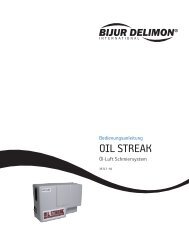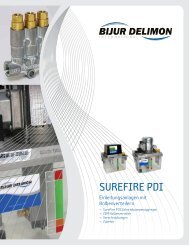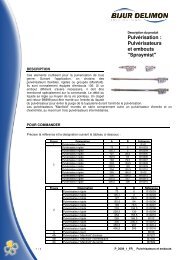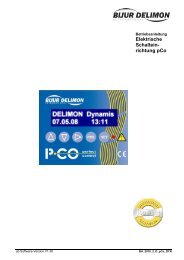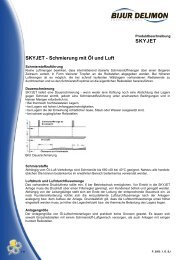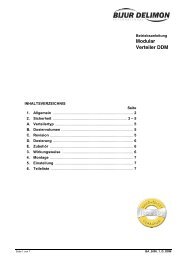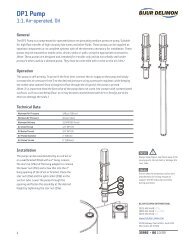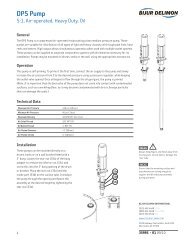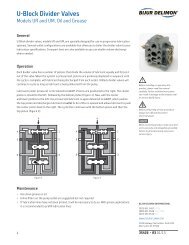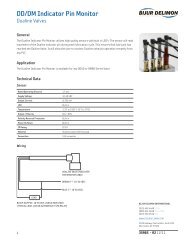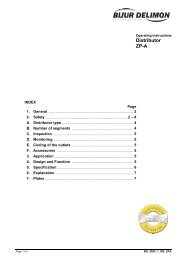Pump FZ-A - Bijur Delimon
Pump FZ-A - Bijur Delimon
Pump FZ-A - Bijur Delimon
Create successful ePaper yourself
Turn your PDF publications into a flip-book with our unique Google optimized e-Paper software.
5. Rotational direction of drive<br />
All pumps can be arranged for clockwise or anti-clockwise running, as required, with the same power and<br />
without modifications.<br />
6. Specifications<br />
Permissible back pressure: ............................................................................................................... 200 bar<br />
for a short time: .............................................................................................................. 250 bar<br />
Permissible pump piston speed:<br />
with running drive: ................................................................................................................... max. 10 r.p.m.<br />
with oscillating drive: .............................................................................................................. max. 16 r.p.m.<br />
Number of oscillating strokes: .............................................................................................. max. 300 min. -1<br />
In case that higher speed or less then < 1 is requested and also when distributors ZPA or E 4 are installed<br />
downstream, ask manufacturer.<br />
In case of using the oscillating lever drive, the lever rod should be installed in such a way, that the<br />
amplitude of the oscillating lever is same in both directions ∝ 1 = ∝ 2 = max. 50 o<br />
Lever amplitude max. : ........................................................................................................................... 100 o<br />
Lever amplitude min. : ............................................................................................................................. 10 o<br />
7. Start-up<br />
Installing and connecting the lubricating pump<br />
The pump should be installed and mounted vertically. Connection of the motor to be control box must be<br />
carried out in accordance with the circuit diagram (paragraph concerning the direction of drive rotation to be<br />
observed).<br />
Filling the lubricant tank and piping<br />
All piping must be carefully cleaned before descaling and blowing through and filled with clean grease<br />
using a grease gun. For initial start-up, the grease tank is first filled up to the strainer with oil and then with<br />
grease, because otherwise a longer start-up time is required to allow venting. Before connecting the piping<br />
the pump must operate long enough at full capacity to ensure that the grease emerges evenly and without<br />
air from each outlet. Next, the piping should be connected (use sealing washers), until air-free grease<br />
emerges at the ends of the piping.<br />
Once the bearings to be lubricated are also filled with grease, the piping can be connected to the lubricating<br />
points. The system can be started after adjustment of the required lubricant quantity.<br />
Setting the delivery rate (figure 3)<br />
At full capacity, corresponding to 0.1 cm 3 lubricant per discharge and piston stroke, an arrow on the<br />
discharge identification points to the number 4 stamped on the head of the setting spindle (2.5). By turning<br />
the spindle clockwise the delivery is reduced. Reduction below 1/4 of the max. delivery (setting 1) should<br />
be avoided. In case of pumps having 7 to 12 outlets, the delivery rate of two vertically arranged outlets is<br />
adjusted by means of an adjusting spindle. The second arrow of the discharge identification points to the<br />
outlet bore relating to the setting spindle.<br />
By changing the drive speed or the internal gear ratio of the pump or also by changing the altitude of the<br />
oscillating lever, the output volume of all outlets and thus the overall output volume is changed.<br />
Page 12 of 14 BA_2005_1_GB_<strong>FZ</strong>A



